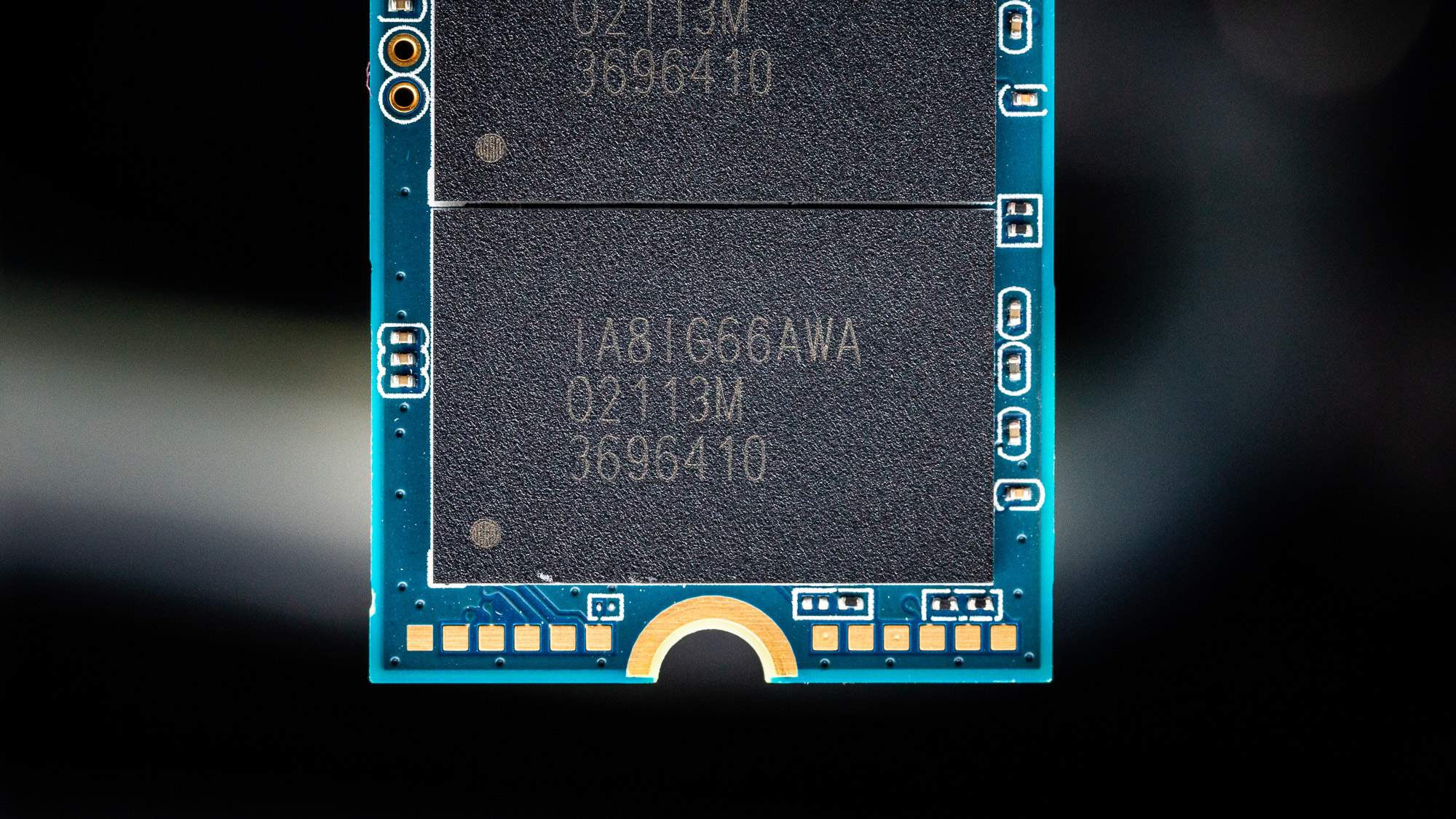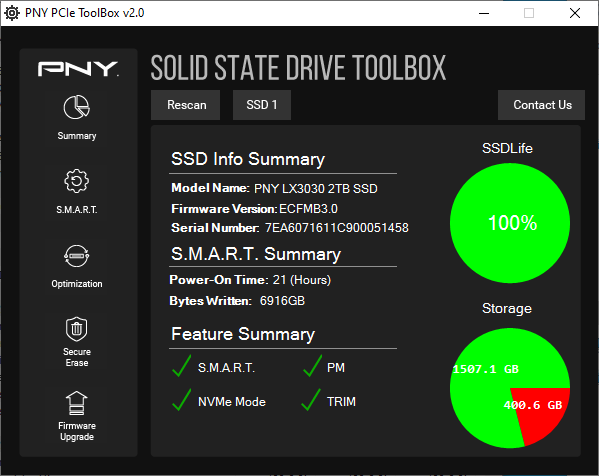Tom's Hardware Verdict
PNY’s LX3030 is a Chia-plotting workhorse that delivers fast, consistent performance to handle the rigorous demands of plotting and also has the high endurance needed to survive the wear it causes.
Pros
- +
+ Fast PCIe 3.0 performance
- +
+ Write speed does not degrade until full
- +
+ Very high endurance ratings
Cons
- -
Costly
- -
Limited availability
- -
Short warranty for 1TB model
Why you can trust Tom's Hardware
While standard-grade SSDs will serve the average PC user for years on end, they typically can't handle the rigorous performance demands of plotting Chia. PNY's LX3030, on the other hand, is built specifically with Chia plotting in mind. As a result, it provides both high-performance and enterprise-level endurance, making it a perfect pick if you're starting or still building multi-petabyte Chia coin farms.
The PNY LX3030 is an interesting piece of hardware. It comes powered by Phison's PS5012-E12S SSD controller but it is outfitted with Micron's 96-Layer QLC flash to take on the grizzly challenges of Chia plotting. Now, you may think to yourself, 'wait a minute, QLC flash on a supposedly high-performance and endurance SSD?' In short, yes.
Although the SSD is built with QLC flash, it doesn't behave like one. To handle the heavy workloads, the flash is programmed to function in SLC mode, much like the technique we described in our FuzeDrive review. However, instead of limiting that to a small region of flash, the company uses 8TB of QLC flash as 2TB of usable SLC.
This means that, unlike conventional consumer storage, the PNY LX3030 is closer to being an enterprise SSD because its write speeds won't degrade much at all, even after hammering it with multiple terabytes of sustained write workloads. Therefore, the LX3030's consistent performance profile should be very appealing to storage enthusiasts just as much as Chia farmers, but it is expensive and is a bit limited by its PCIe 3.0 interface compared to newer PCIe 4.0-equipped SSDs.
Specifications
| Product | 1TB | 2TB |
| Pricing | $819.99 | $1,169.99 |
| Capacity (User / Raw) | 1024GB / 1024GB | 2048GB / 2048GB |
| Form Factor | M.2 2280 | M.2 2280 |
| Interface / Protocol | PCIe 3.0 x4 / NVMe 1.3 | PCIe 3.0 x4 / NVMe 1.3 |
| Controller | Phison PS5012-E12S | Phison PS5012-E12S |
| DRAM | DDR3 | DDR3 |
| Memory | Micron 96L QLC | Micron 96L QLC |
| Sequential Read | 3,200 MBps | 3,200 MBps |
| Sequential Write | 2,400 MBps | 2,400 MBps |
| Endurance (TBW) | 10,000 TB | 20,000 TB |
| Chia Plotting Endurance (TBW) | 27,000 TB | 54,000 TB |
| Part Number | M280LX3030-1TB-RB | M280LX3030-2TB-RB |
| Warranty | 2-Years | 5-Years |
PNY's LX3030 is available in 1TB and 2TB capacities, and even though it's a PCIe 3.0 x4 device, each is more expensive than your average PCIe Gen4 SSD. The drives weigh in at $819.99 and $1,169,66, respectively. Due to the LX3030's specialized application and high cost, the drive won't sell in large volumes. As such, it is primarily available as build-to-order through PNY.com, though a few will be available at select retailers.
The LX3030 is rated for up to 3.2/2.4 GBps read/write, but it lacks random IOPS ratings. As for warranty, strangely, the company only backs the 1TB LX3030 with a short two-year warranty but gives the 2TB model a lengthier five-year warranty. PNY rates the LX3030 with two endurance ratings, too; one for Chia, and one for anything else. If you use the LX3030 solely for Chia plotting, the company backs it for up to a monstrous 54,000 TB of writes, but only 20,000 TB for other workloads.
Software and Accessories
PNY provides a downloadable SSD Toolbox. It isn't as extensive or polished as something like Samsung Magician or WD's SSD Dashboard, but it provides basic functionality such as SMART data monitoring. It also allows you to manually Trim your SSD, secure erase it, and update the firmware if an update is available.
Get Tom's Hardware's best news and in-depth reviews, straight to your inbox.
A Closer Look


PNY’s LX3030 comes in an M.2 2280 double-sided form factor due to the amount of raw flash onboard.


The LX3030 is powered by Phison’s PS5012-E12S, a PCIe 3.0 x4 NVMe 1.3 SSD controller that supports four NAND packages on each side of the PCB. The E12S leverages a dual-core CPU that clocks in at 666 MHz along with a dual-CPU co-processor to sustain high write performance with minimal degradation. It also takes advantage of two 8Gb packages of Kingston DDR3 clocking 1,600 MHz for accelerating FTL mapping table access and snappy performance.
The SSD is built on a 12nm process for efficiency and to keep it cool under load. It also features ASPM, ASPT, L1.2, and has thermal throttle support for further energy efficiency and maintaining cool temperatures under load. It also supports Trim, SMART data reporting and can be securely erased via the Format NVM command. The company even says it is compliant with OPAL hardware encryption specifications, a nice bonus for those who want to lock down their data.



The 2 TB drive has a total of eight terabytes of Micron’s 96L QLC flash, and each die measures 1024Gb and interfaces at 666 MTps. Since the controller features 32 chip enables, these dies are arranged as two dies per chip enable, and the controller uses multi-die select bits to manage each.
The LX3030’s factory overprovisioning is 7.4% for bad block management, garbage collection, and other background processes. It also takes advantage of an AI engine and Low-Density Parity-Check (LDPC) ECC to achieve its multi-petabyte endurance ratings.
MORE: Best SSDs
MORE: How We Test HDDs And SSDs
MORE: All SSD Content

Sean is a Contributing Editor at Tom’s Hardware US, covering storage hardware.
-
Lord_Moonub Great review - really interesting kit. There’s a few extra things that would be great to discuss though.Reply
Anyone deciding whether to use this for Chia plotting today would probably be comparing to using Intel Optane storage. Since XCH is first came out, a lot of changes have taken place and plotting is now possible using a RAM disk for most of the writes, instead of burning through lots of SSD endurance. Using tools like MadMax, farmers are using all the CPU threads to create one plot very quickly, instead of creating lots of plots in parallel. This also means we need less SSD space in total. We only need maybe 200GB of SSD space, tied with 128GB RAM; rather than “the old days” where we were plotting lots of plots in parallel and used a lot of SSD space (maybe a few TB of SSD space).
So a great plotting system today probably uses 128GB RAM, and 250GB of Intel Optane storage as the scratch disk. The Optane storage is fast and (like this PNY drive) doesn’t see a performance degradation when the “cache” is filled.
with this in mind, the comparison for Chia performance probably comes down to the endurance of the drives. This is really what the article is missing right now. What is the cost per plot between these two approaches. (It’s obviously also worth calls this out for the comparison with the other drives. The Corsair and Samsung drives are offering TBW warranties around 600 to 900, and Sabrent have a few up in the 3600TBW. I think from memory Optane is massively higher … but is it still a winning option on $ per TBW versus this PNY drive ?)
anyway, thanks for the continued interest and coverage on Chia stuff. It isn’t very mainstream so great to see it still covered.
